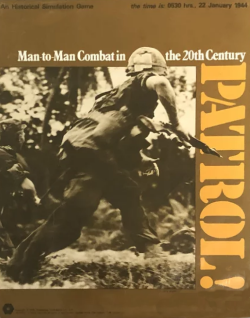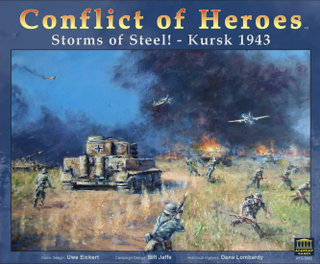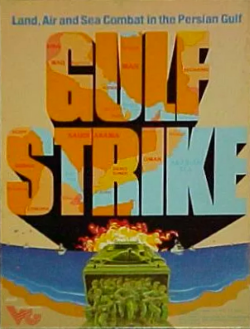
A wargame is a strategy game in which two or more players command opposing armed forces in a simulation of some military operation. Wargaming may be played for recreation, to train military officers in the art of strategic thinking, or to study the nature of potential conflicts. Many wargames re-create specific historic battles, and can cover either whole wars, or any campaigns, battles, or lower-level engagements within them. Many simulate land combat, but there are wargames for naval and air combat, as well.

Miniature wargaming is a form of wargaming in which military units are represented by miniature physical models on a model battlefield. The use of physical models to represent military units is in contrast to other tabletop wargames that use abstract pieces such as counters or blocks, or computer wargames which use virtual models. The primary benefit of using models is aesthetics, though in certain wargames the size and shape of the models can have practical consequences on how the match plays out.

Tabletop games or tabletops are games that are normally played on a table or other flat surface, such as board games, card games, dice games, miniature wargames, or tile-based games.

Battle of the Bulge is a board wargame published by Avalon Hill (AH) in 1965 that simulates the World War II battle of the same name. General Anthony McAuliffe (ret.), who had been commanding officer at Bastogne during the Battle of the Bulge, was a consultant during the game's development. The game proved popular and sold more than 120,000 copies, but was dogged by criticisms of historical inaccuracies, and was finally replaced by a completely new edition in 1981. A third edition in 1991 was released as part of the Smithsonian American History Series.
Sniper!, subtitled "House-to-House Fighting in World War II", is a two-player board wargame about man-to-man combat in urban environments during WWII, originally released in 1973 by Simulations Publications Inc. (SPI). After TSR purchased SPI in 1982, TSR released an expanded edition of Sniper! in 1986, and followed up that up with releases of various "companion games" and a videogame.

Patrol, subtitled "Man to Man Combat in the 20th Century", is a skirmish-level board wargame published by Simulations Publications Inc. (SPI) in 1974 as a sequel to Sniper!, which had been released the previous year. Whereas Sniper! was set in urban environments during the Second World War, Patrol is set in a non-urban environment, in various conflicts ranging from 1914 to 1970.

Don't Give Up the Ship is a set of rules for conducting Napoleonic era naval wargames. The game was published by Guidon Games in 1972 and republished by TSR, Inc. in 1975. The game was developed as a collaboration between Dave Arneson, Gary Gygax, and Mike Carr. It was the first collaboration between Dave Arneson and Gary Gygax, the co-authors of Dungeons & Dragons. Mike Carr edited the rules and researched the historical single ship actions that are included as game scenarios.

Naval wargaming is a branch of the wider hobby of miniature wargaming. Generally less popular than wargames set on land, naval wargaming nevertheless enjoys a degree of support around the world. Both historical and fantasy rulesets are available.
The Wargames Research Group(WRG) is a British publisher of rules and reference material for miniature wargaming. Founded in 1969 they were the premier publisher of tabletop rules during the seventies and eighties, publishing rules for periods ranging from ancient times to modern armoured warfare, and reference books which are still considered standard works for amateur researchers and wargamers. They are best known for their seminal ancient and medieval period rules, and also for De Bellis Antiquitatis and Hordes of the Things fantasy rules.

Conflict of Heroes: Storms of Steel, the second installment of the Conflict of Heroes board wargame series by Academy Games, was published in 2009. The game simulates the Battle of Kursk on the Eastern Front during World War II.

Micro armour refers to scale models made of lead, pewter, die cast metal or plastic, usually used for wargaming purposes. Variations of the name include: mini armour, microscale, mini tanks, miniature armour, miniature tanks, micro tanks, minitanks, minifigs, armour figurines, tank figurines, etc. are also used. Micro armour is a sub-category of model military vehicle miniature figures used for military simulation, miniature wargaming, scale models, dioramas and collecting.
I Ain't Been Shot Mum! is a World War II tabletop skirmish miniatures wargame produced by Too Fat Lardies.

Angriff!, subtitled "A practical set of World War II Wargaming rules for use with the HO and MICRO scale enthusiast", is a set of rules for miniature wargaming set in World War II designed especially for use with HO scale and 1:285 scale micro armor. The booklet was released by Z&M Publishing Enterprises in 1968.
Panzer Campaigns is a series of operational level wargames originally developed by John Tiller Software, and currently by Wargame Design Studio. The games were originally published until 2010 by HPS Simulations, then self published by John Tiller Software until being bought out by Wargame Design Studio in 2021, after Tiller's death. There are currently 29 titles in the series, spanning the various fronts of World War II.

Fire and Fury is a miniatures wargame about the American Civil War.

Korps Commander, or "Korps Commander: The Road to Berlin" is a set of micro-armour Miniature wargaming rules designed by Bruce Rea Taylor and Andy Ashton and published in the UK by Tabletop games, August 1988.

Corps Commander, or "Corps Commander: Operational Manoeuvre Group" is a set of micro-armour Miniature wargaming rules designed by Bruce Rea Taylor and Andy Ashton and published in the UK by Tabletop games copyrighted by B. A. Rea Taylor, A. Ashton & Tabletop Games July 1986.

Wargamer's Digest was a wargaming magazine created by Gene McCoy that was published from 1973 to 2000. It is notable as one of the earliest publications to publish the work of Gary Gygax, and for the high regard that military professionals and academics showed for its military scenarios and simulations.

Gulf Strike, subtitled "Land, Air and Sea Combat in the Persian Gulf", is a board wargame published by Victory Games in 1983. The first and second editions were hypothetical games focussed on American responses to Iranian aggression in the Persian Gulf. The third edition, published in 1990, was updated to reflect the reality of Operation Desert Shield during the First Gulf War.